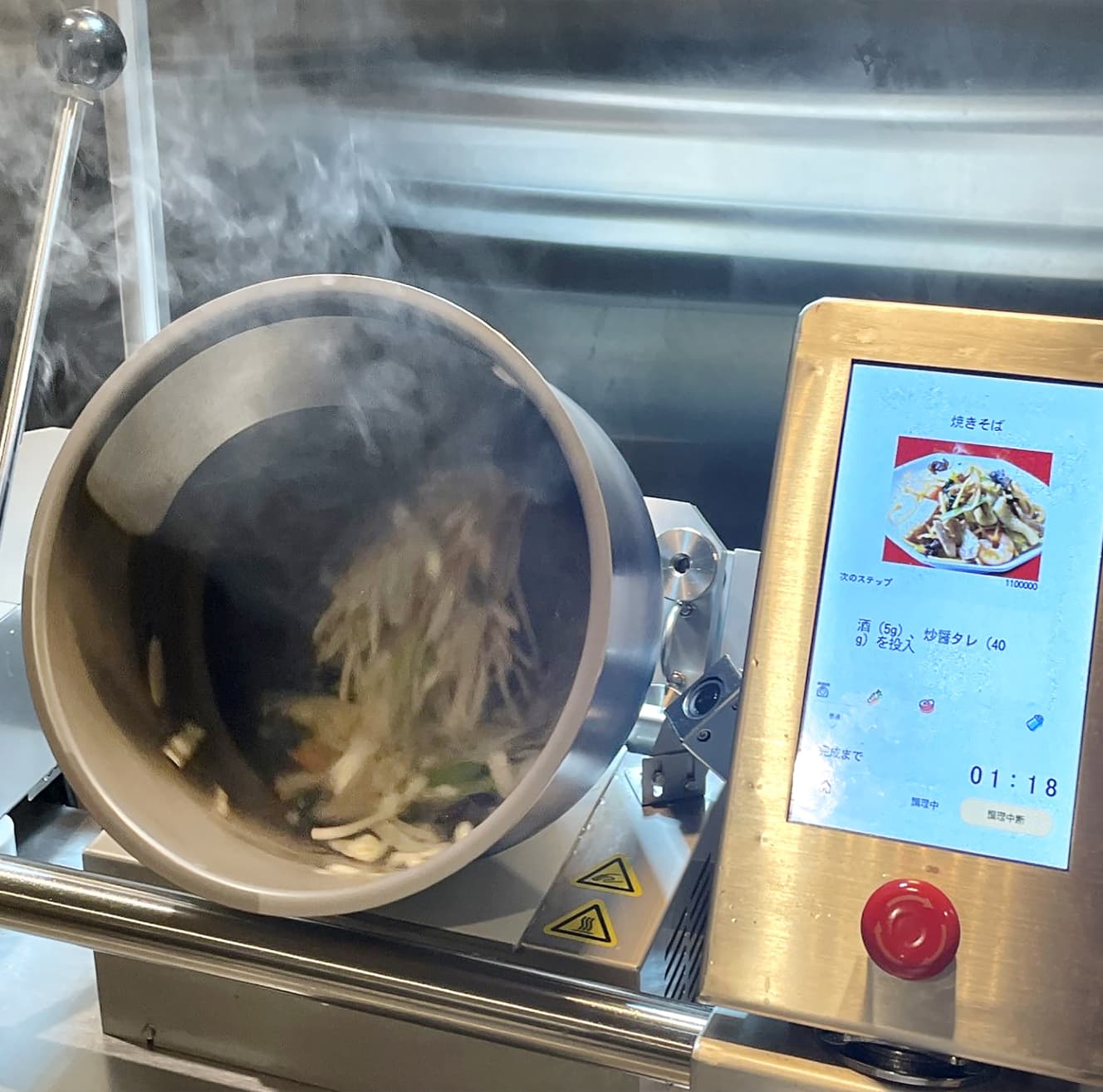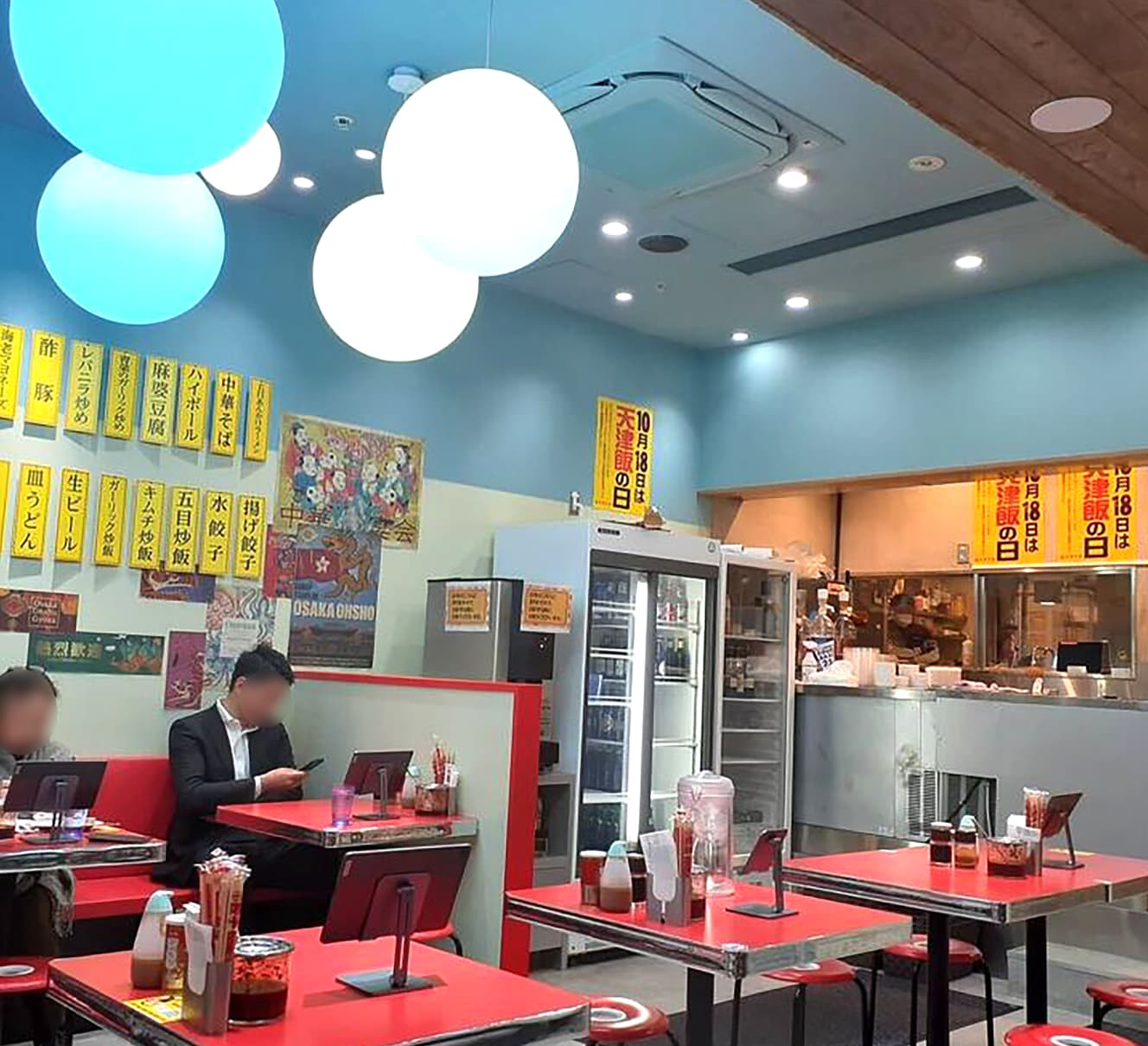Hidakaya, Ohsho, Bamiyan, Gyoza no Manchurian… “Low-priced Chinese Chains”: A Comprehensive Chart of Their Power in 2023
Gyoza no Ohsho and Osaka Ohsho / Hidakaya, which caters to the demand for a quick drink / Bamiyan, which utilizes the know-how of Suhaila / Korakuen, which seeks a comeback with the return of its founder / Gyoza no Manzu, which is growing rapidly, etc.

In the kitchen of a Chinese restaurant, there is a machine that looks like a drum-type washing machine.
The restaurant is located about a five-minute walk from JR Gotanda Station. Osaka Ohsho Nishi-Gotanda is a relatively small restaurant with 34 seats and an interior reminiscent of a Taiwanese food stall. The restaurant is relatively small, with 34 seats, and each table is equipped with a touch panel, which is the same as at other Osaka Ohsho restaurants. However, three machines in the back of the cooking area were unique. As the reporter looked closely at them, a waiter inserted vegetables and seasonings and operated a touch panel. The machines began to spin around and around, and after a few moments, stir-fry dishes emerged from inside, billowing with steam.
It was I-Robo, a robot specially designed for stir-fry cooking, which was introduced on October 1 of this year. The signature item, “Jibunzari Vegetable Stir-Fry” (690 yen), allows customers to select seasoning, additional vegetables, and type and amount of meat from a touch panel on the tabletop, allowing I-Robo to cook stir-fried vegetables to their own liking.
Vegetables such as bean sprouts, cabbage, and carrots are cooked through but crispy. The vegetables, such as bean sprouts, cabbage, and carrots, are cooked through, but they are crispy. There is no squishy, unpleasant texture as if overcooked. It is comparable to those made by veteran artisans. The Nishi-Gotanda branch is the only restaurant that has introduced this robot, but it is likely that the aim is to promote automation while maintaining the quality of the food in the future. Ringer Hut, a Nagasaki chanpon specialty restaurant, has succeeded in this initiative, and the same taste can be served anywhere,” says food journalist Junnosuke Nagahama.
The I-Robo can cook 20 types of dishes, including the mainstay “Fried Lembanilla” and about 60 other items on the menu, such as “Fried Rice with Five Meat Dishes” and “Chinjaolo Rice.
At a time when the cost of raw materials is skyrocketing and the entire restaurant industry is undergoing drastic price hikes, budget Chinese chains are one of the few that are on the side of the common man. On the other hand, a chronic problem in the industry as a whole is the shortage of labor. Either they should take advantage of the introduction of cooking robots and DXing of their stores to save labor, or they should improve the treatment of their employees to secure human resources. Both are heavy decisions for businesses selling at low prices, and companies are being cautious. Also, the ability to expand demand beyond the mainstay lunchtime meal for busy office workers and gut-busting meals for students will determine whether budget Chinese chain restaurants can survive in the future,” said economic journalist Takashi Matsuzaki.
Hidakaya was one of the first to recognize these issues in the industry and has been expanding its power by responding to the demand for “choti-nomi” (casual drinking).
Compared to food, alcoholic beverages have a higher profit margin,” said Takashi Matsuzaki, an economic journalist. So, after the COVID-19 crisis subsided, Hidakaya added the phrase “choti nama” (“a little drink”) to its signage. Cho-i-no-Izakaya chain izakaya are inexpensive, but they charge an appetizer fee. 1,000 yen for a beer, gyoza, stir-fry, etc., is a very valuable combination. Hidakaya also offers less hearty dishes such as the “Vegetable Filled Tangmen” and morning dishes such as the “450 yen Morning Set Meal,” which are popular among women and the elderly.
Hidakaya had about 200 stores as of 2008, but has now grown to about 400 stores. It is expected to continue to expand its power in the future.
In fact, Hidakaya seems to be aiming to open a new store right next to a McDonald’s. When McDonald’s opens a new store, it is usually located near a train station. When opening a new store, McDonald’s carefully researches whether it will be profitable or not, taking into account the number of passengers and the flow of people at the station and the market price of rent. It is a smart strategy for an operator of low-priced products,” said a restaurant industry journalist.

A Champion Going Against the Theory
In contrast to Hidakaya, Korakuen, which had been increasing the number of its restaurants at a breakneck pace in the past, is now struggling in the red without being able to create a new strategy.
Since Korakuen originally opened a large number of roadside restaurants, customers tend to come to the restaurant by car, and it is difficult to expect them to come to the restaurant for a quick bite to eat or drink. The new business since Noboru Niida, the son of the company’s founder, Den Niida (79), took over as president has been fraught with failure. He sold “Chocolate Ramen” on Valentine’s Day and developed “Vegan Gyoza” (both sold out) with the popular chef Shusaku Toba, but both were not well-received. Both were not well-received! Steak” and “Yakiniku Like” to replace unprofitable restaurants, but in the long run, this is also a bad move. Furthermore, operators such as Hidakaya, which had been expanding their presence in urban areas, have begun to move into roadside areas, Korakuen’s turf, over the past five years, and the company is in deep trouble. In order to revive the business, the founder, Mr. Den, has been reappointed to the board this year. His skills are attracting attention.
Bamiyan, which is operated by Sukai-Laak, is also struggling with many roadside restaurants that do not sell alcohol, but it has adopted a survival strategy that takes advantage of the group’s know-how.
The company has succeeded in saving on labor costs with the use of catering robots, a specialty of the company’s restaurants. The restaurants in poor locations have been replaced by the affiliated all-you-can-eat dim sum restaurant, Momotai, in an effort to increase the amount of food sold per customer.
Securing and training human resources, and succeeding in new businesses: these are the key to survival in the budget Chinese restaurant chain industry, where one must meet strict requirements. In the budget Chinese restaurant chain industry, where one must clear severe conditions to survive, the king of the pack, “Gyoza no Ousho,” with approximately 700 stores, reigns as the overwhelming leader with a strategy that seems to go against the times.
Gyoza no Ousho does not use cooking robots and does not rely heavily on central kitchens. In other words, they are going against the grain in terms of labor saving. The main selling point is that people make the food in the restaurant, and even the signature product, gyoza, is baked in the restaurant by the chef. Original menus can also be developed at the discretion of each store. This is the exact opposite of the theory of chain restaurants, which is that the headquarters manages and standardizes each store. This bold initiative is made possible by the company’s overwhelming human resource development capabilities. We maintain the quality of our service through a full range of programs, including the ‘Ohsho Cooking Dojo’ for training chefs, ‘Ohsho University’ for learning store management, and compliance training,” says Matsuzaki.
One such example is “Gyoza no Manzu,” which has 100 stores.
Gyoza-no-Manshu, which has 100 stores, is one such company. They also offer a wide variety of rice bowls and ramen noodles in addition to gyoza, and I think they will be a growing company in the future.
Is it an investment in labor savings, in people, or in ideas to improve profit margins? The firepower in the war between budget Chinese chains, with Gyoza no Ohsho at the top, is getting higher and higher.



From the December 8-15, 2023 issue of FRIDAY
PHOTO: Jiji Press, Kyodo News
